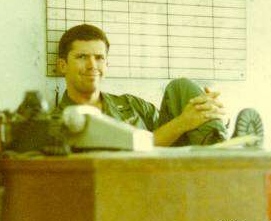Sea Tiger
A Weekly Newspaper Published by:
III Marine Amphibious Force,
Vietnam
May 1970
Snakebite Marine Medevaced
By GySgt. James J. Oggerino
Da Nang - "It's going to be one of those days," said Cpl. Terry McDade
(Ogden, Utah), a crew chief with HMM-364 at Marble Mountain here.
The comment was made during a medevac 20 miles southwest of Charlie Ridge,
when an injured Marine was brought aboard the medevac helicopter by cable
hoist.
On the second mission of the day 5 miles southwest of An Hoa, the
helicopter touched off a booby trap. The rest of the morning was
routine.
The first call of the afternoon came from Happy Valley, 15 miles
northwest of An Hoa. An Injured reconnaissance Marine, suffering
from snakebite, had to fight his way through eight foot high elephant grass
before he could be taken aboard. "It was a routine day after all,"
commented Cpl. McDade at the conclusion of the day's medevac runs.
Congratulations Pilots
It has been 58 years since Lieutenant Alfred Cunningham in his fragile
biplane launched the Marine Corps into the age of aviation. Since
that time Marines have fought in the skies over France, the Caribbean,
the Pacific, Korea and now the Republic of Vietnam, adding new chapters
to a proud history.
To the officers and men who are responsible for the unparalleled
efficiency of our close air support, resupply, medical evacuation and reconnaissance,
my congratulations and sincere appreciation on this, the 58th anniversary
of Marine aviation.
LtGen. Keith B. McCutcheon
Commanding General, III MAF
Medevac Chopper Angel of Mercy
By SSgt.Mike La Bonne
Da Nang - A helicopter makes a rapid descent to the landing pad at
the Naval Supply Activity (NSA) hospital, south of Da Nang. Stretcher
bearing corpsman race to the helicopter to retrieve a wounded Marine: a
medevac. Scenes like this are a daily occurrence. For men who
work in the theater of armed conflict are ensured a starring role in medevacs.
 How
does a medevac work? How do the helicopters get to the area so fast?
Who keeps the patient alive until he reaches the hospital? To find
these answers, let's fly with 1stLt. Ben L. Williams (San Jose, Calif.),
a pilot from HMM-34, Marble Mountain Air Facility. The ground element
is one of many Marine infantry units in the field.
How
does a medevac work? How do the helicopters get to the area so fast?
Who keeps the patient alive until he reaches the hospital? To find
these answers, let's fly with 1stLt. Ben L. Williams (San Jose, Calif.),
a pilot from HMM-34, Marble Mountain Air Facility. The ground element
is one of many Marine infantry units in the field.
Action starts with ground Marines on an operation in search of the
enemy. Ravines, ridges and dense jungle growth hamper efforts and
hide the worst enemy of all - the booby trap. The infantry point
man, inching his way through shoulder high elephant grass, triggers a booby
trap. Immediately the corpsman goes to work to keep the man alive
and a radio call is flashed to the unit's command which is relayed to the
Direct Air Support Center (DASC) in Da Nang.
1stLt. Williams, section leader of two CH-46 Sea Knight Helicopters
- on call 24 hours a day - gets the terse message from DASC, Emergency
medevac!" In a matter of minutes they are airborne, along with two
gun ships to provide suppressive fire if needed. Lt. Williams double
check coordinates while his corpsman prepares for the patient. Minutes
later the chopper is in radio contact with the ground unit. Williams
is told from which direction enemy fire is coming from or can be expected.
A smoke grenade is popped. In a tight, sharp spiral, Williams drops
quickly to the landing zone. The medevac is rushed aboard.
Immediately the corpsman begins work to keep his patient alive, while the
helicopter corkscrews up and away towards NSA at top speed. From
start to finish, Lt. Williams' evacuation took 10 to 15 minutes.
Contents of this page copied from articles published in the "Sea
Tiger" during May 1970
Submitted by:
Pat Kenny, former 1stLt. USMCR
Back Browser or Home
 How
does a medevac work? How do the helicopters get to the area so fast?
Who keeps the patient alive until he reaches the hospital? To find
these answers, let's fly with 1stLt. Ben L. Williams (San Jose, Calif.),
a pilot from HMM-34, Marble Mountain Air Facility. The ground element
is one of many Marine infantry units in the field.
How
does a medevac work? How do the helicopters get to the area so fast?
Who keeps the patient alive until he reaches the hospital? To find
these answers, let's fly with 1stLt. Ben L. Williams (San Jose, Calif.),
a pilot from HMM-34, Marble Mountain Air Facility. The ground element
is one of many Marine infantry units in the field.